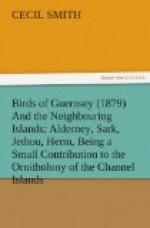175. FULMAR PETREL. Fulmarus glacialis, Linnaeus. French, “Petrel fulmar.”—The Fulmar Petrel, wandering bird as it is, especially during the autumn, at which time of year it has occurred in all the western counties of England, very seldom finds its way to the Channel Islands, as the only occurrence of which I am aware is one which I picked up dead on the shore in Cobo Bay on the 14th of November, 1875, after a very heavy gale. In very bad weather, and after long-continued gales, this bird seems to be occasionally driven ashore, either owing to starvation or from getting caught in the crest of a wave when trying to hover close over it, after the manner of a Shearwater, as this is the second I have picked up under nearly the same circumstances, the first being in November, 1866, when I found one not quite dead on the shore near Dawlish, in South Devon. It must be very seldom, however, that the Fulmar visits the Channel Islands, as neither Mr. Couch nor Mrs. Jago had ever had one through their hands, and Mr. MacCulloch has never heard of a Channel Island specimen occurring.
It is not included in Professor Ansted’s list, and there is no specimen in the Museum.
176. STORM PETREL. Thalassidroma pelagica Linnaeus. French, “Thalassidrome tempete.”—Mr. Gallienne, in his remarks published with Professor Ansted’s list, says, “The Storm Petrel breeds in large numbers in Burhou, a few on the other rocks near Alderney, and occasionally on the rocks near Herm; these are the only places where they breed, although seen and occasionally killed in all the Islands.” I can add to these places mentioned by Mr. Gallienne the little island, frequently mentioned before, near Sark, Le Tas, where Mr. Howard Saunders found several breeding on the 24th June, 1878. I could not accompany him on this expedition, so he alone has the honour of adding Le Tas to the breeding-places of the Storm Petrel in the Channel Islands, and he very kindly gave me the two eggs which he took on that occasion. When I visited Burhou in June, 1876, I was unsuccessful in finding more than part of a broken egg and a wing of a dead bird. But Colonel L’Estrange, who had been there about a fortnight before, found two addled eggs, but saw no birds. I thought at the time that I had been too late and the birds had departed, but this does not seem to have been the case, as Captain Hubback wrote to me in July of this year (1878), and said, “Do you not think that perhaps you were early on the 14th of June? Of the six eggs I took on the 2nd of July this year, two were quite fresh, three hard-sat, and one deserted.” I have no doubt he was right, as the wing of the dead bird I found was, no doubt, that of one that had come to grief the year before, and the egg was one which had been sat on and hatched, and might therefore have been one of the previous year; and the same, possibly, might have been the case with Col. L’Estrange’s two addled eggs. It appears, however, to be rather




